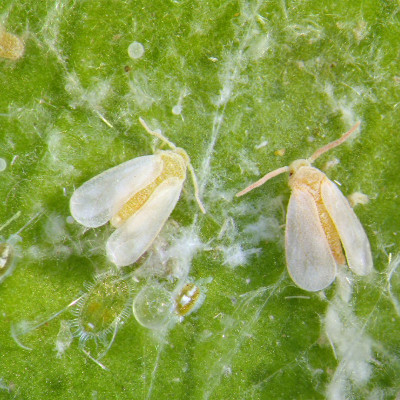Whitefly can be a major pest in greenhouses and conservatories. They suck the sap out of plant leaves, excreting a sticky substance known as honeydew, which in turn can encourage fungal growth called sooty mould.
What is Whitefly
Whitefly are insects which, as the name suggests, are white. They feed on the leaves of many ornamental plants and vegetables.
How to spot Whitefly
As they feed on the underside of leaves turning over leaves will reveal the insects or a white dust.
Sticky leaves indicate honeydew and a black coating on top of the stickiness is likely to be sooty mould.


How to control Whitefly
These are some of the measures that I try to employ to reduce the impact of these pests.
The parasitic wasp Encarsia formosa is commonly used to predate on them. You can buy them online or from your local garden centre.
Whitefly are attracted to yellow. And yellow sticky traps, I’ve bought them in the past, do work well. All you need to do is hang them inside the greenhouse – a simple option.
Another way to control whitefly in a greenhouse is to fumigate them. The simplest way to do this is by lighting garlic candles. Suitable for use at any time of the year, whitefly are repelled by the smell of garlic. Best of all the candle will not taint any fruit or veg growing that you have in there.
Make sure you keep on top of plants in your greenhouse too. Remove any plants that you no longer want to keep. This will reduce the chances of whitefly finding a home. And remember to make sure there is good ventilation in there too. Good airflow prevents the spread of not just pests, but also mould and or diseases that can impact plant health.
Should you spot any honeydew and sooty mould, this can be wiped off affected leaves with a clean, damp cloth.
Remember in winter to give your greenhouse a good clean too. This will help with the removal of any whitefly that are trying to overwinter in there.



Need advice
If you need specialist advice, I would always recommend you speak to your local garden centre, plant nursery or contact the advisory service of the Royal Horticultural Society. Each of these organisations has expert knowledge that can make pest control so much easier. And when speaking to a garden centre or nursery that is local to you, the chances are they will know whether there has been an influx in pests too.

Leave A Comment